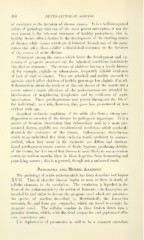Page 482 - My FlipBook
P. 482
480 DENTO-ALVEOLAR ABSCESS. —
of" resistance to the invasion of (lis(>aso causes. It is a Avell-recognized
axiom of })athology that one of the most ])otent antiseptics, if not tlie
most j)otent, is the inherent resistance of healtliy protophism ; that is,
healthy tissues offer a barrier to the development of the exciting causes
of disease, while tissues which are debilitated through any of the many
causes that affect them exhibit a diminished resistance to the invasion
of the causes of acute disease.
Prominent among the causes which favor the development and ex-
tension of pyogenic processes are the inherited conditions indefinitely
classified as strumous. The tissues of children having a family history
of, for example, syphilis or tuberculosis, frequently exhibit evidences
of lack of vital resistance. They are attacked and readily succumb to
tigencies which affect children of healthy parentage but slightly if at all.
Inflammations about the teeth or of the soft tissues of the mouth run a
severe course ; septic affections of the pericementum are attended by
involvement of neighboring lymphatics and by evidences of septic
intoxication. These predispositions may persist throughout the life of
the individual ; as a rule, however, they grow less pronounced or less
evident with age.
Acquired cachectic conditions of the adult also form a strong pre-
disposition to invasion of the tissues by pathogenic organisms. It is a
matter of frequent observation that tuberculosis and, in a more pro-
nounced degree, syphilis are constitutional conditions which markedly
diminish the resistance of the tissues. Inflammatory disturbances
which in an individual free from cachexia would probably be circum-
scribed, when they occur in the cachectic are diffuse and virulent.
Local predisposing causes consist of faulty hygiene, producing debility
of the tissues, for it is noted that abscess is more likely to run a virulent
course in unclean mouths than in those kept free from fermenting and
putrefying masses ; this is a general, though not a universal truth.
Pathology and Morbid Anatomy.
The pathology of septic pericementitis has been described in Chapter
XVII. That of alveolar abscess begins as soon as there is death of
cellular elements in the exudation. The exudation is liquefied in the
focus of the inflammation by the action of ferments ; the leucocytes are
invaded by and strive to devour the pyogenic cocci which are present
the species of warfare described by Metchnikoff; the leucocytes
succumb, die, and form pus corpuscles, which are found to contain the
pyogenic cocci. The cellular exudate is then broken down into a
granular detritus, which, with the dead corpuscles and peptonized effu-
sion, constitutes pus.
The diplococcus of pneumonia is said to be a constant attendant


